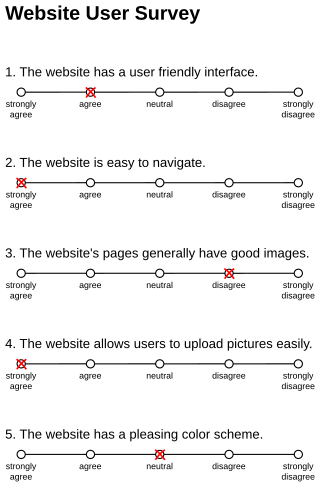Related Research Articles
Usability testing is a technique used in user-centered interaction design to evaluate a product by testing it on users. This can be seen as an irreplaceable usability practice, since it gives direct input on how real users use the system. It is more concerned with the design intuitiveness of the product and tested with users who have no prior exposure to it. Such testing is paramount to the success of an end product as a fully functioning application that creates confusion amongst its users will not last for long. This is in contrast with usability inspection methods where experts use different methods to evaluate a user interface without involving users.
Concept testing is the process of using surveys to evaluate consumer acceptance of a new product idea prior to the introduction of a product to the market. It is important not to confuse concept testing with advertising testing, brand testing and packaging testing, as is sometimes done. Concept testing focuses on the basic product idea, without the embellishments and puffery inherent in advertising.

An interview is a structured conversation where one participant asks questions, and the other provides answers. In common parlance, the word "interview" refers to a one-on-one conversation between an interviewer and an interviewee. The interviewer asks questions to which the interviewee responds, usually providing information. That information may be used or provided to other audiences immediately or later. This feature is common to many types of interviews – a job interview or interview with a witness to an event may have no other audience present at the time, but the answers will be later provided to others in the employment or investigative process. An interview may also transfer information in both directions.
Questionnaire construction refers to the design of a questionnaire to gather statistically useful information about a given topic. When properly constructed and responsibly administered, questionnaires can provide valuable data about any given subject.
Survey methodology is "the study of survey methods". As a field of applied statistics concentrating on human-research surveys, survey methodology studies the sampling of individual units from a population and associated techniques of survey data collection, such as questionnaire construction and methods for improving the number and accuracy of responses to surveys. Survey methodology targets instruments or procedures that ask one or more questions that may or may not be answered.
Qualitative marketing research involves a natural or observational examination of the philosophies that govern consumer behavior. The direction and framework of the research is often revised as new information is gained, allowing the researcher to evaluate issues and subjects in an in-depth manner. The quality of the research produced is heavily dependent on the skills of the researcher and is influenced by researcher bias.
A respondent is a person who is called upon to issue a response to a communication made by another. The term is used in legal contexts, in survey methodology, and in psychological conditioning.

A questionnaire is a research instrument that consists of a set of questions for the purpose of gathering information from respondents through survey or statistical study. A research questionnaire is typically a mix of close-ended questions and open-ended questions. Open-ended, long-term questions offer the respondent the ability to elaborate on their thoughts. The Research questionnaire was developed by the Statistical Society of London in 1838.

Response bias is a general term for a wide range of tendencies for participants to respond inaccurately or falsely to questions. These biases are prevalent in research involving participant self-report, such as structured interviews or surveys. Response biases can have a large impact on the validity of questionnaires or surveys.

An opinion is a judgment, viewpoint, or statement that is not conclusive, rather than facts, which are true statements.
Cognitive pretesting, or cognitive interviewing, is a field research method where data is collected on how the subject answers interview questions. It is the evaluation of a test or questionnaire before it's administered. It allows survey researchers to collect feedback regarding survey responses and is used in evaluating whether the question is measuring the construct the researcher intends. The data collected is then used to adjust problematic questions in the questionnaire before fielding the survey to the full sample of people.
Computer-assisted web interviewing (CAWI) is an Internet surveying technique in which the interviewee follows a script provided in a website. The questionnaires are made in a program for creating web interviews. The program allows for the questionnaire to contain pictures, audio and video clips, links to different web pages, etc. The website is able to customize the flow of the questionnaire based on the answers provided, as well as information already known about the participant. It is considered to be a cheaper way of surveying since one doesn't need to use people to hold surveys unlike computer-assisted telephone interviewing. With the increasing use of the Internet, online questionnaires have become a popular way of collecting information. The design of an online questionnaire has a dramatic effect on the quality of data gathered. There are many factors in designing an online questionnaire; guidelines, available question formats, administration, quality and ethic issues should be reviewed. Online questionnaires should be seen as a sub-set of a wider-range of online research methods.
An expert report is a study written by one or more authorities that states findings and offers opinions.
Linguistic validation is the process of investigating the reliability, conceptual equivalence, and content validity of translations of patient-reported outcome (PRO) measures.
With the application of probability sampling in the 1930s, surveys became a standard tool for empirical research in social sciences, marketing, and official statistics. The methods involved in survey data collection are any of a number of ways in which data can be collected for a statistical survey. These are methods that are used to collect information from a sample of individuals in a systematic way. First there was the change from traditional paper-and-pencil interviewing (PAPI) to computer-assisted interviewing (CAI). Now, face-to-face surveys (CAPI), telephone surveys (CATI), and mail surveys are increasingly replaced by web surveys. In addition, remote interviewers could possibly keep the respondent engaged while reducing cost as compared to in-person interviewers.

Computer-assisted survey information collection (CASIC) refers to a variety of survey modes that were enabled by the introduction of computer technology. The first CASIC modes were interviewer-administered, while later on computerized self-administered questionnaires (CSAQ) appeared. It was coined in 1990 as a catch-all term for survey technologies that have expanded over time.
A research participant, also called a human subject or an experiment, trial, or study participant or subject, is a person who voluntarily participates in human subject research after giving informed consent to be the subject of the research. A research participant is different from individuals who are not able to give informed consent, such as children, infants, and animals. Such individuals are preferentially referred to as subjects.
A translation project is a project that deals with the activity of translating.
Behavior coding, or behavioral coding, is a research method for evaluating questionnaire design and survey interviewer performance and interaction.
Expert review or expert evaluation is a method to evaluate survey questions from the perspective of one or more experts.
References
- ↑ "Anchoring Vignettes Overview". gking.harvard.edu. Retrieved 2024-02-17.
- ↑ Hu, Mengyao (2019). "Using anchoring vignettes to correct for differential response scale usage in 3MC surveys". Advances in comparative survey methods: Multinational, multiregional, and multicultural contexts (3MC). Wiley Publishing. pp. 181–201.
- ↑ Patrick, Vargas (2008). "Vignette Question". In Lavrakas, Paul (ed.). Encyclopedia of Survey Research Methods. Sage Publishing. p. 948. doi:10.4135/9781412963947. ISBN 9781412918084.
- ↑ Willis, Gordon (2005). Cognitive interviewing: A tool for improving questionnaire design. Sage. p. 146. ISBN 9780761928041.
- ↑ Aizpurua, Eva (2020). Sha, Mandy; Gabel, Tim (eds.). Pretesting methods in cross-cultural research (Chapter 7) in The essential role of language in survey research. RTI Press. pp. 129–150. doi: 10.3768/rtipress.bk.0023.2004 . ISBN 978-1-934831-23-6.
- ↑ Martin, Elizabeth (2004-06-25). "Vignettes and Respondent Debriefing for Questionnaire Design and Evaluation". In Presser, Stanley; Rothgeb, Jennifer M.; Couper, Mick P.; Lessler, Judith T.; Martin, Elizabeth; Martin, Jean; Singer, Eleanor (eds.). Methods for Testing and Evaluating Survey Questionnaires (1 ed.). Wiley. doi:10.1002/0471654728. ISBN 978-0-471-45841-8.
- ↑ Sha, Mandy (2016-08-01). "The Use of Vignettes in Evaluating Asian Language Questionnaire Items". Survey Practice. 9 (3): 1–8. doi: 10.29115/SP-2016-0013 .